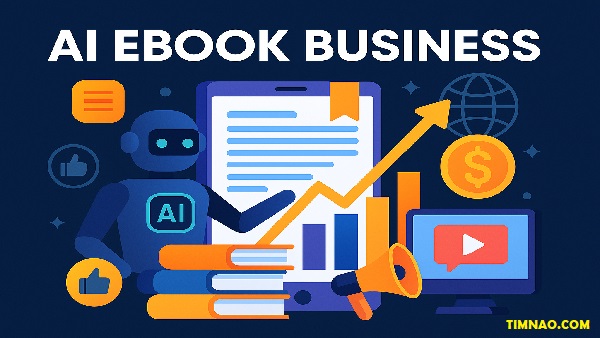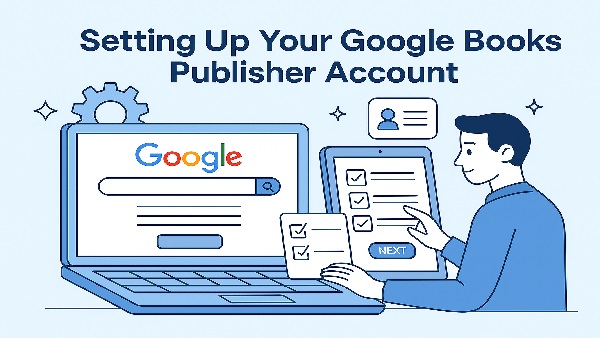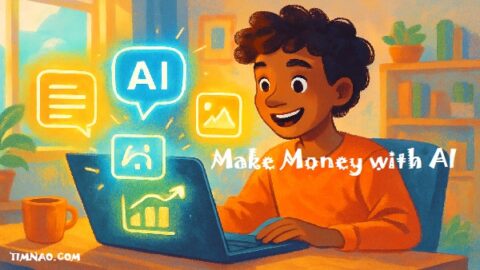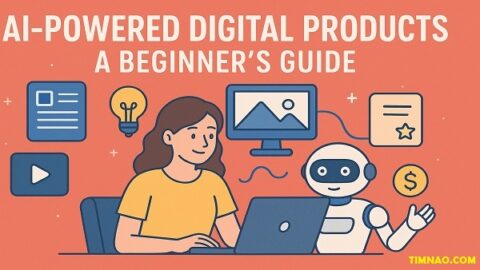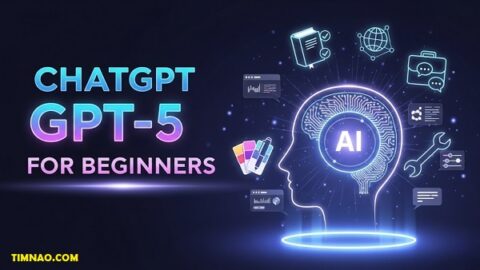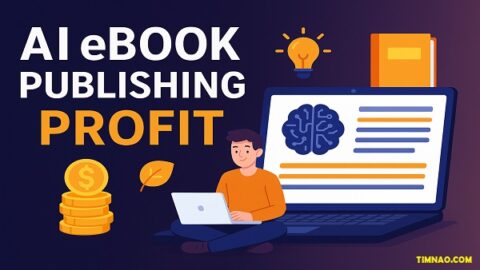🤑 How to Unlock Explosive Passive Income with AI eBooks — The Hidden $1K/Day Strategy 🚀
AI eBook business is rapidly becoming one of the most accessible and scalable ways to earn money online — even if you’ve never written a book before. Thanks to powerful tools like Deepseek AI and platforms like Google Books, aspiring creators can now generate, design, and sell professional-quality eBooks without the usual hurdles of writing, formatting, or marketing.
Whether you’re a side hustler, freelancer, or first-time digital entrepreneur, this complete step-by-step guide will show you exactly how to build a profitable, automated income stream by leveraging AI — from topic research to publishing, promotion, and scaling your results. You’ll discover how to turn digital content into a real asset that works for you 24/7, reaching a global audience with minimal upfront investment.
If you’ve ever wondered how people make money from self-publishing or want to future-proof your income with AI-driven tools, you’re in the right place.
Now let’s dive into the full roadmap for launching and growing your own AI-powered publishing empire. 👇
📚 Table of Contents
- 🧠 Why AI-Powered eBook Publishing Is a Game Changer
- 🚀 Tools of the Trade: Deepseek AI and Google Books Explained
- 🔧 Step-by-Step: Setting Up Your Google Books Publisher Account
- 🌍 Discovering Viral Niches with Deepseek AI
- ✍️ Creating Quality eBooks with AI (Without Writing a Word)
- 🎨 Designing and Formatting Your eBook Like a Pro
- ⚠️ Finalizing Your eBook with Disclaimers and Compliance
- 📤 Publishing Your eBook on Google Books
- 📣 Promoting Your eBook on Social Media (Smart Automation Tips)
- 📝 Driving Traffic with SEO Blog Content
- 📈 Scaling the System: Multiply and Monetize
- 🧭 Smart Tips to Maximize Your Long-Term Earnings
🧠 Why AI-Powered eBook Publishing Is a Game Changer
The rise of artificial intelligence has radically reshaped content creation — and eBook publishing is one of the biggest winners.
Gone are the days of spending weeks writing, formatting, and editing a book. Today, AI-powered eBook publishing enables anyone — even complete beginners — to generate and publish high-quality digital books in a matter of hours. This new wave of technology removes the barriers of writing skills, design knowledge, or marketing experience.
At the heart of this shift is the AI eBook business model. Instead of treating content creation as a one-time project, smart entrepreneurs are building scalable digital product empires — powered by automation.
💡 What Makes It So Powerful?
- No Need to Be a Writer: You don’t need to be an author or even fluent in English to publish a book. Tools like Deepseek AI generate full chapters from a single keyword or outline.
- Low Cost, High Profit: With almost zero overhead and global digital delivery, your profit margins can exceed 90%.
- Unlimited Scale: Once published, an eBook can sell 24/7 in multiple countries without additional effort.
- Multiple Streams of Income: A single eBook can feed blog content, email funnels, short-form videos, and affiliate products — all pointing back to your book.
The best part? AI doesn’t just write for you — it helps you identify trending topics, format content, and even promote your books with social posts and blog articles.
This is not about gaming the system. It’s about using today’s most advanced tools to work with the system — smarter, faster, and more creatively than ever before.
🚀 Tools of the Trade: Deepseek AI and Google Books Explained
To unlock the power of the AI eBook business, you need two essential tools:
- Deepseek AI – Your content-generating assistant
- Google Books – Your global publishing platform
Let’s break them down.
🤖 What is Deepseek AI?
Deepseek AI is an advanced content-generation platform built to do more than just write paragraphs. It mimics human thinking and shows you its reasoning, making the content more logical and editable.
Whether you’re creating an outline, fleshing out chapters, or writing blog articles, Deepseek AI helps you:
- Discover trending topics by scanning the internet in real-time
- Generate outlines, titles, and full drafts with a single prompt
- Refine tone and structure to match your style or audience
- Expand content with examples, lists, FAQs, or case studies
- Create blog posts and social media content for promotion
It’s not just a text tool — it’s a business builder for modern digital creators.
📘 What is Google Books?
Google Books Partner Center is Google’s official publishing platform that allows you to upload and sell eBooks globally.
Think of it as Google’s version of Amazon KDP — but with some unique advantages:
- Massive Reach: Integrated directly into Google Search and the Play Store, your eBook is discoverable by billions of users worldwide.
- Direct Gmail Access: With over 3 billion Gmail users, promoting your eBook inside Google’s ecosystem is seamless.
- Simple Setup: Upload a PDF, set a price, and you’re in business — no coding, no ISBN required.
- Automatic Payouts: Earnings are sent directly to your bank account without third-party processors.
🧩 Why These Two Tools Work Perfectly Together
Deepseek AI handles the content, and Google Books handles the distribution. When used together, they give you a powerful system for:
- Finding hot topics people actually search for
- Quickly turning ideas into professional-looking eBooks
- Publishing to a global audience with no technical skills
- Earning income while you sleep
This combination allows you to run a lean, automated eBook publishing business that scales as much as you’re willing to create.
In the next section, you’ll learn exactly how to set up your Google Books account, link your payment profile, and prepare your first upload — even if you’re starting from zero.
🔧 Step-by-Step: Setting Up Your Google Books Publisher Account
Before you can start selling your AI-generated eBooks, you’ll need to create your Google Books Publisher account — the gateway to publishing and earning.
The process is beginner-friendly and requires no advanced tech skills. Just follow this simple step-by-step guide to get set up and ready to publish.
🛠️ Create Your Google Books Publisher Profile
- Go to the Google Books Partner Center. Click “Get Started.”
- Sign in using a Google account. Preferably use one tied to your business or content brand.
- Fill in your publisher name (your real name, pen name, or business name).
- Accept the terms and create your publisher dashboard.
Once your account is active, you’ll see a clean interface to manage all your books, track sales, and monitor performance.
💰 Set Up Your Payment and Tax Information
To receive payments from book sales, you’ll need to:
- Create a Payment Profile under the “Payments” tab
- Enter your bank account details (no PayPal needed)
- Submit your tax information (U.S. W-9 or local equivalent)
This setup ensures Google can deposit your royalty earnings directly into your bank account.
🧠 Pro Tip: Use a business account for cleaner bookkeeping and easier tax filing later.
📘 Prepare to Upload Your First Book
Once payments are sorted, click “Add a Book” to begin your first upload:
- Input your book title, author name, and description
- Upload your PDF file (we’ll cover formatting in the next section)
- Upload your cover image (JPG or PNG)
🎯 Use SEO keywords in your book title and description to improve visibility in Google Search and Play Store listings.
✅ Understand Google’s Content Policies
To avoid having your eBook rejected, make sure it aligns with Google’s publishing rules:
- No copied or plagiarized material
- No hate speech, explicit content, or misleading titles
- Disclose if AI assisted in content creation (we’ll show you how)
🔐 Pro Tip: Add a short disclaimer at the end of your book to ensure transparency and compliance.
Now that your account is set up and you’re ready to publish, it’s time to choose the right niche — the key to consistent eBook sales.
🌍 Discovering Viral Niches with Deepseek AI
The success of your AI eBook business depends on choosing the right topics — ones that people are actively searching for.
That’s where Deepseek AI becomes your personal niche detective.
🔍 Why Niche Research Matters
Publishing an eBook on a topic that no one’s searching for is like opening a shop in the desert. To make real money, you need to ride the wave of trending interest.
With Deepseek AI, you can spot:
- Viral trends before they peak
- Underserved niches with high demand and low competition
- Evergreen topics that continue selling over time
🧠 How to Find Winning Topics with Deepseek AI
Here’s how to use Deepseek AI’s topic generation feature like a pro:
- Log in to Deepseek AI and choose the “Content Ideas” or “Topic Discovery” tool
- Enter broad keywords like:
AI in healthhow to make money onlinehome fitnessfreelance skills for beginners
- Review the list of generated subtopics based on real-time data from Google Trends, YouTube, social platforms, and news articles
- Select ideas that meet the “3C” criteria:
- Current (trending now)
- Clear (easy to understand)
- Commercial (can lead to sales or monetization)
📌 Example Search:
Prompt: “List 10 hot eBook topics related to AI and passive income in 2025”
💡 Output:
- “AI Tools for Remote Freelancers”
- “How to Build a Passive Income Stream with Chatbots”
- “2025 Guide to AI-Powered Investing for Beginners”
These are the types of topics that make people stop, click — and buy.
🎯 Niche Categories That Work Well in 2025
According to the latest trends, here are high-performing eBook niches to explore:
| Category | Hot Topics |
|---|---|
| AI & Tech | AI for small business, automation tools, prompt engineering |
| Finance | Passive income with AI, crypto tools, side hustles |
| Health & Wellness | AI meal planning, digital fitness coaching |
| Education | AI learning hacks, homeschooling with AI tutors |
| Entrepreneurship | Building a one-person business with AI |
Start with what you’re interested in — but validate it with data before writing.
🛠️ Deepseek Prompt Template:
Prompt: “Generate a list of trending and profitable eBook ideas in [your niche] for [year]”
The result? A laser-focused list of data-backed ideas that are easy to turn into high-performing eBooks.
In the next section, you’ll learn exactly how to turn these ideas into fully written eBooks using Deepseek — without spending days or even hours writing from scratch.
✍️ Creating Quality eBooks with AI (Without Writing a Word)
You don’t need to be a professional writer to launch a successful AI eBook business. In fact, you don’t need to write anything at all.
Thanks to powerful tools like Deepseek AI, creating high-quality, ready-to-publish digital books is as simple as giving a few clear instructions. From outlining chapters to writing detailed sections, AI handles the heavy lifting — while you stay in control of the content’s direction and tone.
Let’s break down how to turn your chosen topic into a full eBook in just a few hours.
🧱 Step 1: Generate a Clear Outline
The first step in creating an AI-assisted eBook is crafting a well-structured outline. This gives your book a logical flow and sets the foundation for each chapter.
Use this simple prompt in Deepseek AI:
Prompt: “Generate a complete eBook outline with chapters and subheadings on [Your Topic].”
📘 Example:
Topic: “How to Build Passive Income with AI Tools”
Output:
- Chapter 1: What Is Passive Income?
- Chapter 2: AI Tools That Can Automate Income
- Chapter 3: Setting Up Your AI Workflow
- Chapter 4: Case Studies from Real Users
- Chapter 5: Scaling Your Automation
Review and adjust the outline based on your goals and what your audience might expect.
✨ Step 2: Expand Each Chapter Automatically
Once your outline is ready, let Deepseek write each chapter for you.
Here’s the workflow:
- Input each chapter title as a separate prompt.
- Use detailed instructions to guide the AI on tone, length, or structure.
- Review the generated content — then polish if needed.
💬 Sample prompt:
“Write Chapter 2 of an eBook titled ‘Passive Income with AI.’ Focus on beginner-friendly AI tools like ChatGPT, Jasper, and Copy.ai. Use a simple tone, with examples.”
Deepseek will return a detailed, coherent draft — ready for use with minimal editing.
🔍 Step 3: Customize with Your Unique Touch
Even the best AI needs a human editor to ensure the final product feels authentic and trustworthy.
Here are ways to personalize your content:
- Insert your experiences or commentary (“In my case, I used Jasper to automate emails and saved 10+ hours/week.”)
- Add bullet points, tips, or real-world examples
- Break up long paragraphs for better readability
- Use a consistent tone and formatting style throughout the book
🧠 Bonus Tip: Ask Deepseek to rewrite sections in different tones — friendly, professional, or motivational — to better suit your audience.
🛠️ Step 4: Include Engaging Visuals and Calls-to-Action
A great eBook isn’t just words on a page — it’s an experience.
Enhance your content with:
- Illustrations generated by Leonardo AI
- Simple graphs or infographics using free tools like Canva
- Breakout sections for quotes, warnings, or step-by-step instructions
- Calls-to-action (CTAs) like “Download this toolkit” or “Follow me on Threads for updates”
📌 Tip: Include CTAs in every few chapters to increase engagement and conversion.
📘 Sample Workflow: Creating an eBook in a Day
Let’s say your topic is “AI for Freelancers.”
Here’s a streamlined creation process:
- Outline Prompt:
“Generate a 7-chapter outline for an eBook titled ‘AI for Freelancers: Work Less, Earn More.’” - Chapter Prompt:
“Write Chapter 3: Using AI to Create Client Proposals in Minutes. Use examples from Fiverr and Upwork.” - Repeat this for each chapter and assemble the content in Google Docs.
- Polish the wording, adjust tone, and add visuals.
- Save as PDF — and you’re ready to publish on Google Books.
🔁 Tips to Keep in Mind
- Stay Focused on One Topic per book to maintain clarity
- Don’t overuse AI jargon — speak your audience’s language
- Edit manually or with Grammarly to ensure clean, readable content
- Keep chapters short and structured (ideal: 1,000–1,500 words per chapter)
When you combine Deepseek’s capabilities with your creative direction, you can create eBooks that not only inform but also convert readers into buyers.
In the next section, we’ll walk you through formatting and designing your eBook to meet publishing standards — and stand out from the crowd visually.
🎨 Designing and Formatting Your eBook Like a Pro
Once you’ve generated and refined your content with Deepseek AI, the next step is to format it professionally and create visuals that make your book stand out.
Whether your goal is to make money with Google Books or establish credibility in your niche, presentation matters. A well-designed eBook builds trust, improves readability, and increases conversion — which means more downloads and more income.
Let’s walk through how to format, style, and design your eBook to publishing perfection.
📝 Step 1: Format the Content in Google Docs
The simplest and most effective tool for formatting your eBook is Google Docs. It’s free, cloud-based, and allows you to export clean PDFs that are fully compatible with Google Books.
Here’s how to format like a pro:
- Start with a new document and paste in your edited content
- Use consistent heading styles for titles, chapters, and subheadings
- Add page breaks between chapters to keep layout clean
- Apply uniform fonts (e.g., Lora or Roboto for readability)
- Set line spacing to 1.5 for better readability
- Add a table of contents at the beginning (Google Docs generates this automatically based on headings)
✅ Bonus Tip: Keep paragraphs short and use bullet points or icons to break up long blocks of text — this improves mobile reading experience.
🖼️ Step 2: Create an Eye-Catching Cover with Leonardo AI
Your cover is the first thing potential readers see. A professionally designed cover instantly increases click-through rates and sales.
Use Leonardo AI to generate stunning visuals for your eBook in minutes — even if you have zero design skills.
🧠 Cover Design Prompt Example:
Prompt: “Modern digital book cover for a non-fiction eBook titled ‘AI for Side Hustles.’ Include tech-themed illustrations, minimalist layout, and bold fonts. Color theme: blue and gold.”
Once the image is generated, you can:
- Crop or resize it using Canva or Photopea
- Add title text, author name, and subtitle
- Export as JPG or PNG at high resolution
💡 Keep your cover dimensions around 1600 x 2560 pixels to meet most eBook standards.
📖 Step 3: Add Visuals and Layout Elements Inside the eBook
Design isn’t just for the cover — enhancing the interior of your eBook keeps readers engaged.
Here’s what you can add:
- Chapter Illustrations using Leonardo AI (e.g., icons, infographics)
- Divider graphics to visually separate sections
- Callout boxes for key tips, tools, or stats
- Clickable links to your website, social media, or affiliate offers
🧩 Example Section Layout:
[Chapter Header]
[Brief Intro Paragraph]
[Main Content – broken into H3 subheadings]
[Quote or Stat Box]
[Illustration]
[Call-to-Action or Summary]
📌 Tip: Make sure your visual design supports your branding. If you plan to publish multiple eBooks, use a similar color palette, font family, and layout across all titles to build brand recognition.
📄 Step 4: Export and Prepare for Upload
Once everything is in place:
- Double-check formatting for alignment and consistency
- Ensure all links are clickable and images display correctly
- Go to File → Download → PDF Document (.pdf)
- Save your eBook with a clean filename like:
ai-side-hustles-guide.pdf
🧠 Pro Tip: Also save a .docx backup in case you need to update the file later.
You’ll upload this finalized PDF to your Google Books account along with your cover image during the publishing process.
✅ Design Tips for a Professional Touch
- Keep it clean: Don’t overcrowd your layout with graphics or fonts
- Use contrast: Make headers and CTA buttons stand out with color
- Stay consistent: Pick one style for all your books — this builds trust
- Use white space: Let your design breathe; don’t cram everything together
Remember: Great design increases perceived value. If your eBook looks like it could cost $19.99 — readers are more likely to pay $9.99 or click “Buy.”
Once your eBook is fully designed and formatted, you’re almost ready to publish. But before you hit upload, there’s one final legal step: adding a disclaimer.
In the next section, we’ll cover how to finalize your eBook for publishing — including compliance, disclaimers, and your pre-launch checklist.
⚠️ Finalizing Your eBook with Disclaimers and Compliance
Before you publish your eBook, there’s one last essential task: making sure it complies with Google Books’ publishing standards.
This step protects your AI eBook business from policy violations and builds transparency with your readers — especially when your book involves financial tips, AI-generated content, or health-related advice.
🛡️ Why You Need a Disclaimer
A disclaimer clarifies:
- That your book was created with the help of AI tools
- That it is for informational purposes only
- That you are not liable for how the reader uses the content
This is crucial if your eBook includes:
- Money-making advice
- Health, fitness, or wellness tips
- AI-generated or experimental content
- Personal development techniques
Failing to add a disclaimer could result in rejection by Google Books or loss of reader trust.
✍️ Where and How to Add the Disclaimer
Location: Place the disclaimer at the end of your eBook, right before any appendices or bonuses.
Format: Use a clear heading like “Disclaimer” and keep the text short and professional.
📘 Example Disclaimer:
This eBook was created with the assistance of artificial intelligence (AI) tools. The information provided is for educational and informational purposes only. The author and publisher make no guarantees regarding financial results and are not responsible for any actions taken based on the content.
You can adjust this based on your niche. For example, if your eBook includes health tips, add:
This is not medical advice. Always consult a professional before making health-related decisions.
📋 Final Pre-Publish Checklist
Before you upload to Google Books, double-check:
✅ Content flows logically and is free of major errors
✅ Visuals and links are working properly
✅ Title, subtitle, and metadata are finalized
✅ Cover is properly sized and branded
✅ Disclaimer is included
✅ File is saved as a high-resolution PDF
Once you’ve checked every box, you’re ready to take your AI eBook business live!
📤 Publishing Your eBook on Google Books
Uploading your finished eBook to Google Books Partner Center is fast and beginner-friendly.
Follow this simple guide to launch your book globally and start earning.
🚀 Step-by-Step: Upload Your Book to Google Books
- Log in to your Publisher Account
- Click “Add Book” in the dashboard
- Choose the publishing type:
- Sell worldwide (recommended)
- Preview only if you don’t want to sell yet
📝 Fill In Book Details
Google will prompt you to enter:
- Title and subtitle (include relevant keywords)
- Author name or pen name
- Book description (make this engaging and SEO-rich)
- Category and subject (choose up to 3 that match your niche)
- Keywords or tags (e.g., “AI tools,” “digital income,” “freelancing”)
💡 Tip: Use phrases your target audience would type into Google — this improves your discoverability and sales.
📎 Upload Your Files
- Upload the PDF version of your eBook
- Upload your cover image (JPG or PNG, 1600px wide recommended)
You’ll get a preview of how your book will appear on desktop and mobile. Review it carefully — this is how the world will see your work.
💸 Set the Price and Distribution
- Choose your eBook price (start at $9.99 for strong perceived value)
- Decide which countries to distribute in (select all for maximum reach)
- Enable DRM protection if you want to prevent copying or unauthorized sharing
🔁 You can adjust your price later based on reader feedback and performance.
🧠 Understand the Review Process
Once submitted, your eBook goes through Google’s internal review, which checks for:
- Copyright violations
- Content quality
- Compliance with publishing guidelines
- Accuracy of metadata and descriptions
⏱️ The process usually takes 2–5 business days. You’ll receive an email once your book is approved or if it needs revisions.
✅ Your Book Is Now Live!
Once approved, your eBook will:
- Be available on Google Play Books globally
- Show up in Google Search results
- Be accessible from Android devices, tablets, and even Gmail-connected platforms
📈 Use the analytics tools in your Partner Center dashboard to:
- Track downloads and purchases
- See which countries are driving traffic
- Identify top-performing books over time
📣 Pro Tips for a Stronger Launch
- Include a call-to-action in your book description:
“Download now and start your journey with AI-powered income.”
- Ask friends or early readers to leave Google Play reviews
- Promote your book via blog posts and social media (covered in the next section)
- Monitor performance weekly and test price changes or metadata updates
With your first book live, you’ve taken the most important step in building a profitable AI eBook business. From here, it’s all about marketing and scaling.
In the next section, we’ll show you how to promote your eBook on social media using automation — and drive steady sales without spending a cent on ads.
📣 Promoting Your eBook on Social Media (Smart Automation Tips)
Publishing your eBook is just the beginning. To make money with Google Books, you need traffic — and social media is one of the fastest, cheapest, and most effective ways to get it.
The good news? You don’t have to post manually every day or become a full-time influencer. With a few smart strategies and AI-powered tools, you can automate the entire process and generate consistent clicks and sales — even while you sleep.
🎯 Why Social Media Promotion Matters
If your goal is to build a sustainable AI eBook business, you need visibility. Social platforms like X (formerly Twitter), Threads, and Instagram give you access to highly targeted audiences — for free.
Each post you make is an opportunity to:
- Build trust and authority in your niche
- Drive traffic to your Google Books listing
- Turn followers into paying customers
- Boost visibility through shares, comments, and hashtags
🧠 Use Deepseek AI to Generate Your Content
Instead of struggling with captions or rewriting the same CTA, let Deepseek AI create your content calendar.
🛠️ Sample Prompt:
“Generate 14 social media posts promoting an eBook titled ‘AI Tools for Passive Income.’ Include a mix of educational tips, questions, quotes, and soft-sell CTAs.”
You’ll receive a diverse mix of post types, such as:
- 🔍 “Want to work less and earn more? Discover how AI tools can automate your income streams. 👉 [Your Book Link]”
- 💬 “What’s your #1 struggle with starting a side hustle? Let’s talk in the comments.”
- 📚 “New Release: AI for Freelancers. Start earning smarter, not harder. #AIincome #GoogleBooks”
Edit for tone and style, then load them into your scheduling tool.
📆 Schedule with Buffer (or Similar Tools)
Buffer, Later, and Publer are beginner-friendly platforms that let you schedule content in advance across multiple platforms.
Setup in 3 Easy Steps:
- Connect your social accounts (X, Threads, Instagram, LinkedIn, etc.)
- Upload 14–30 days’ worth of posts generated by Deepseek AI
- Set your posting frequency (e.g., 1 post/day at 10 a.m.)
This automation keeps your brand visible without daily manual work.
🧠 Pro Tip: Reuse top-performing posts every few weeks — not everyone sees them the first time.
🖼️ Boost Engagement with Visuals
Add scroll-stopping visuals to your posts using Leonardo AI or Canva.
🔥 Visual Ideas:
- 3D mockups of your eBook cover
- Infographics showing steps or stats from your book
- Quotes or excerpts from key chapters
- Carousel posts (Instagram or LinkedIn) that summarize chapter highlights
💡 Prompt Example for Leonardo AI:
“Flat vector illustration of a freelancer using AI tools to generate income, sitting at a modern desk with dollar signs and digital charts around. Color theme: tech blue and gold.”
High-quality visuals can double engagement rates and make your eBook look even more professional.
📌 Don’t Forget to Add Call-to-Actions (CTAs)
Every post should nudge your audience toward taking action. Use clear CTAs like:
- “📘 Grab your copy now on Google Books 👉 [link]”
- “💡 Want to learn how AI can save you 10+ hours/week? This eBook breaks it down.”
- “👇 Comment ‘link’ and I’ll DM you the book.”
Even soft CTAs like “Learn more in my new guide” can convert well without sounding pushy.
📊 Track, Test, and Tweak
Use built-in analytics from:
- Buffer (engagement, click-throughs)
- X Analytics
- Instagram Insights
Look at:
- Which posts generate the most clicks
- What topics resonate with your audience
- The best posting times for your niche
🎯 Double down on what works. Replace low-performing content with better variations.
💼 Bonus Strategy: Repurpose for More Platforms
One post = multiple formats.
Here’s how to repurpose a single idea:
| Original Post | Repurpose Ideas |
|---|---|
| X tweet | Turn into a Threads thread |
| Instagram carousel | Break into 3 LinkedIn text posts |
| Blog excerpt | Convert into Pinterest pin or YouTube short |
| Quote from eBook | Turn into a Reels-style quote card with voiceover |
This multiplies your reach without multiplying your workload — a core principle of scaling your AI eBook business.
🧭 Weekly Promo Routine (Example)
| Day | Action |
|---|---|
| Monday | Post a tip from your book + image mockup |
| Tuesday | Share a quote or stat from your eBook |
| Wednesday | Ask a question or poll related to your topic |
| Thursday | Share a behind-the-scenes writing tip or tool |
| Friday | Feature a testimonial or user result (real or AI-generated) |
| Saturday | Promote a bonus/freebie tied to your book |
| Sunday | Do a “weekly wisdom” recap post with CTA |
This structure gives variety, builds connection, and maintains consistency.
With social media working for you 24/7, your Google Books eBook gets steady exposure and potential buyers every day — without ads or burnout.
In the next section, we’ll explore how to drive traffic using blog posts and SEO content, turning your eBook into the centerpiece of a complete content ecosystem.
📝 Driving Traffic with SEO Blog Content
Publishing on Google Books and posting on social media is a powerful start — but if you want long-term visibility and passive traffic, you need search engine optimization (SEO).
Creating SEO blog content allows your eBook to show up in Google Search results, bringing you consistent readers — without paying for ads.
Best of all, you can automate this process using Deepseek AI, turning one eBook into a traffic-generating content ecosystem.
🔍 Why Blogging Still Works in 2025
While platforms like TikTok and Threads dominate short-form content, Google Search still handles over 8.5 billion searches per day — and blog posts are among the top-ranking results.
By writing blog content that targets the same audience as your eBook, you can:
- Rank for keywords related to your topic
- Drive organic traffic to your eBook listing
- Build authority and trust over time
- Increase conversion with valuable, informative content
🛠️ Use Deepseek AI to Create Blog Posts
Let AI do the writing for you.
✅ Prompt Example:
“Write a 1,200-word SEO blog post titled ‘Top 5 AI Tools for Passive Income in 2025.’ Target beginners and include soft promotion for an eBook at the end.”
You’ll receive a well-structured draft including:
- Introduction
- List of tools (like Jasper, ChatGPT, Leonardo AI)
- Practical use cases
- Natural transition to a call-to-action linking to your eBook
Tweak the tone, add personal touches or screenshots, and you’re done.
🧠 Tip: Use a consistent voice across your blog and eBook to reinforce your brand.
🧩 Blog Post Structure That Converts
Use this proven layout to engage readers and drive clicks to your Google Books listing:
| Section | Purpose |
|---|---|
| Catchy Headline | Includes your main keyword (e.g., “How to Make Money with AI Tools in 2025”) |
| Hook Paragraph | Connect emotionally or pose a problem your eBook solves |
| Main Body | Offer value: tips, lists, how-tos, or insights based on your eBook topic |
| Internal Links | Link to other blog posts if you have more content |
| CTA Box | Invite the reader to get the full guide (link to your Google Books eBook) |
📘 Sample CTA:
Want to dive deeper into AI tools that generate income on autopilot? Get my full guide — now available on Google Books.
🌐 Where to Publish Your Blog Content
You have several options — use one or combine them all for maximum reach.
- Your Own Website
- Ideal for building a long-term brand
- Use platforms like WordPress or Ghost
- Add a blog section with SEO-optimized articles
- You control the traffic, design, and calls-to-action
- Medium.com
- Fastest way to get started without a website
- Large built-in audience for tech and entrepreneurship
- Add your Google Books link to your author bio and post footers
- Medium Partner Program can earn you extra income via views
- LinkedIn Articles
- Perfect for professional, AI, or finance-related topics
- Great for building authority and networking with potential collaborators
- Repost the same blog article (tweaked slightly) to LinkedIn’s built-in audience
- Substack
- Combine blog and newsletter in one
- Build an email list to promote future eBooks
- Add gated content for premium subscribers
💡 Blog Topic Ideas to Promote Your eBook
To support your AI eBook business, here are SEO blog topics tied to common keyword searches:
| Blog Title | Purpose |
|---|---|
| “5 Ways to Make Passive Income with AI in 2025” | Target readers looking for side hustle ideas |
| “How I Used Deepseek AI to Write and Publish a Book in 2 Days” | Behind-the-scenes content that builds trust |
| “Why Google Books Is the Most Underrated eBook Platform for Creators” | Educates readers and promotes your product |
| “Top AI Tools for Digital Entrepreneurs This Year” | Broad appeal + SEO value |
Use tools like Ubersuggest, Answer the Public, or Google Trends to refine keyword targeting.
✍️ Blogging Consistency = Long-Term Growth
Set a goal to publish 1–2 blog posts per week. Each one can:
- Drive organic traffic to your Google Books eBook
- Introduce new readers to your brand
- Be repurposed into social media content or YouTube scripts
- Support SEO rankings for months or years
You’re not just writing — you’re building a content marketing funnel around your eBook.
🚀 Pro Tips to Boost Blog Performance
- Add alt-text and descriptions to all images for SEO
- Optimize meta titles and descriptions for each post
- Embed internal links to other posts and your eBook page
- Use table of contents plugins to improve navigation
- Update older posts every few months with new stats or offers
Once your blog posts start ranking, you’ll enjoy free traffic and passive eBook sales — a core part of your long-term strategy to make money with Google Books.
With social and search engines both working in your favor, your eBook becomes more than a digital product — it becomes a magnet for leads, readers, and income.
In the next section, we’ll take this further: you’ll learn how to scale your AI eBook business into multiple titles, platforms, and income streams.
📈 Scaling the System: Multiply and Monetize
Once your first eBook is live and making sales, it’s time to shift from publishing to scaling. The goal now is to turn a single successful launch into a profitable AI eBook business — one that runs (mostly) on autopilot and grows month after month.
Scaling doesn’t mean working harder. It means working strategically using systems, automation, and content repurposing.
Let’s break down exactly how to multiply your eBook income and build a long-term, sustainable digital business.
🚀 Publish More eBooks — Fast
The fastest way to increase revenue is to publish more titles.
If your first eBook brings in $50–$100 per week, imagine what 5–10 optimized titles could do.
🛠️ Strategy:
- Use Deepseek AI to identify more trending topics in your niche or adjacent ones
- Reuse your proven outline structure to save time
- Create short eBooks (30–50 pages) focused on solving specific problems
- Use the same brand style, formatting template, and promotional system
📘 Example Series:
- “AI for Freelancers: Work Less, Earn More”
- “AI for Coaches: Automate Your Marketing”
- “AI for Creators: Write, Design, and Sell Without Burnout”
Each new book expands your audience, authority, and earning potential.
🌍 Expand to Multiple Publishing Platforms
While Google Books is powerful, diversifying across other marketplaces boosts your reach and revenue.
Here are the top platforms to consider:
| Platform | Key Advantage |
|---|---|
| Amazon KDP | Largest eBook marketplace in the world |
| Apple Books | Ideal for premium Apple users |
| Kobo Writing Life | Popular in Europe and Asia |
| Barnes & Noble Press | Strong presence in North America |
🧠 Pro Tip: Use the same content and cover design — just format once and republish across all channels. Some tools (like Draft2Digital) even automate this.
🔁 Repurpose Your eBook Content
One eBook can fuel a complete content ecosystem.
Here’s how to get more mileage from every chapter:
- Turn book sections into SEO blog posts
- Extract tips into Instagram carousels or YouTube Shorts
- Record voiceovers reading your chapters as audio snippets or podcast episodes
- Bundle several eBooks into a mini course or membership
📌 Example:
Chapter 3 of your eBook = “AI Tools for Automating Client Proposals”
Repurpose into:
- Blog post: “How I Use AI to Win Freelance Clients”
- Carousel: “3 Proposal Mistakes AI Can Fix for You”
- YouTube Short: “AI Hack: Write Client Proposals in 60 Seconds”
This multiplies your exposure and traffic without creating new content from scratch.
⚙️ Automate and Outsource for Scale
To avoid burnout and free up time, systematize your eBook business using automation and low-cost outsourcing.
Tools to Use:
| Task | Tool |
|---|---|
| Content creation | Deepseek AI |
| Social media scheduling | Buffer, Publer, or Later |
| Image generation | Leonardo AI |
| Formatting & layout | Google Docs + Canva templates |
| Freelance help | Fiverr or Upwork (for editing, covers, formatting) |
🧠 Delegate repetitive tasks so you can focus on strategy and scaling.
📊 Breakdown: Hitting $1,000/Day
Let’s say you sell each eBook at $9.99.
To hit $1,000 per day, you only need:
- 100 eBook sales per day
- That’s 10 eBooks generating 10 sales/day each
- Or 5 books selling 20 copies/day
With global reach, strong topics, and automation, this is entirely achievable — even for solo creators.
🎯 Bonus Monetization Tactics
- Bundle offers: Sell 3 eBooks for $19.99 (more value = more conversions)
- Email list upsells: Offer a bonus workbook or checklist for $5–$9
- Affiliate marketing: Recommend AI tools (like Jasper, Copy.ai) in your eBook with affiliate links
- Low-cost digital products: Add templates, swipe files, or resource kits as upsells
💡 Example: Inside your eBook on “AI for Freelancers,” offer a “Client Proposal Generator Template” as a $7 add-on.
🧭 Your Scalable System Blueprint
- Pick a new topic with Deepseek AI
- Generate and polish your eBook
- Design and format it using Canva + Google Docs
- Upload to Google Books and republish to Amazon KDP
- Promote on blogs, social, and email
- Repeat monthly
This system builds compounding digital income — where every new title boosts the reach and credibility of your brand.
Scaling your AI eBook business doesn’t require hustle 24/7. With the right tools, templates, and mindset, you can turn a single digital product into a six-figure publishing empire — one book at a time.
In the final section, we’ll share timeless tips to help you sustain momentum, avoid common mistakes, and stay profitable in the long run.
🧭 Smart Tips to Maximize Your Long-Term Earnings
Building an AI eBook business that pays you every month isn’t just about publishing more — it’s about playing the long game strategically.
The digital publishing world is evolving quickly. To stay ahead, you need to think beyond short-term wins and focus on sustainable growth, smart positioning, and value-driven content creation.
Here are the most effective strategies to help you maximize your earnings, scale efficiently, and create an income stream that lasts for years.
🔄 1. Refresh and Update Old eBooks
Your first eBook doesn’t have to be perfect — but it should evolve with trends.
Set a reminder to update your top-performing books every 6–12 months. This includes:
- Refreshing data and stats
- Adding new tools or case studies
- Updating your disclaimer if policies change
- Enhancing visuals or layout based on reader feedback
💡 Pro Tip: Re-release updated versions with “2025 Edition” in the title to attract new traffic and boost visibility in Google Books.
📥 2. Build an Email List from Day One
An email list is your most powerful asset.
Use your eBook as a gateway to collect reader emails by offering a free bonus:
- Templates
- Workbooks
- Resource lists
- Early access to future eBooks
🧠 Inside your eBook, add CTAs like:
“Want the bonus tools from this guide? Download them free here: [your landing page]”
Once subscribers are on your list, you can:
- Promote new book releases
- Share blog content
- Upsell premium content or services
- Build long-term trust and community
Tools to use: ConvertKit, MailerLite, or Substack
🔍 3. Follow the Trends — But Don’t Chase Them Blindly
While Deepseek AI helps you stay ahead of trending topics, don’t jump on every hype train.
Instead:
- Focus on trends that align with your niche and audience
- Prioritize evergreen topics that generate long-term traffic
- Validate demand by checking Google Trends or YouTube search data
- Build depth — not just speed
✅ A “timeless + trending” combo (e.g., “Passive Income + AI Tools 2025”) gives you the best of both worlds.
📚 4. Create Themed eBook Series or Funnels
Single eBooks are great — but a series builds a brand.
Instead of scattered topics, structure your books like a journey:
- Book 1: Introduction or beginner’s guide
- Book 2: Intermediate strategies or tools
- Book 3: Scaling or monetization tips
🧩 This creates a value ladder that keeps readers coming back for more.
You can also offer bundles:
“Get all 3 books + bonus tools for just $19.99 (normally $35)”
This not only increases average order value but also positions you as an authority in your niche.
⚙️ 5. Track Your Performance and Pivot Often
To run a profitable AI eBook business, you need data — not guesswork.
Monitor:
- Your best-selling titles and keywords
- Pages with the most clicks (via Google Books analytics or UTM links)
- Social media posts that drive traffic
- Email open rates and click-throughs
🔁 Based on the data, pivot:
- Add new CTAs or bonuses to underperforming books
- Double down on high-performing keywords or platforms
- Experiment with pricing (e.g., $4.99 promo to boost rankings)
Small tweaks often lead to big wins.
💼 6. Treat It Like a Business — Not a Hobby
It’s easy to treat your first few sales like a side hustle. But the real money comes when you treat your eBook publishing as a legit digital business.
That means:
- Setting monthly revenue and content goals
- Creating SOPs (Standard Operating Procedures) for repeatable tasks
- Investing in tools that save time (like Buffer, Deepseek AI, Canva Pro)
- Keeping your financials organized (use Stripe, Wave, or a spreadsheet)
🧠 Mindset shift: Your book isn’t just a product — it’s digital real estate. Each one is an asset that grows in value over time.
💸 7. Diversify Income Streams Around Your Book
Maximize revenue by adding multiple layers to each eBook.
Monetization Ideas:
| Add-On | Description |
|---|---|
| Bonus Template | Include a link to download a PDF worksheet or AI prompt pack |
| Affiliate Links | Recommend tools used in the book (e.g., Jasper, Leonardo AI) |
| Consulting Call | Offer 30-minute calls for $47–$97 if you’re experienced |
| Course/Workshop | Bundle multiple books into a $99 video course |
| Patreon | Offer behind-the-scenes or bonus content monthly |
With just one eBook, you can build a mini ecosystem of products — all automated and scalable.
🚀 Final Thought: Think Long-Term, Act Today
Success in the AI eBook business doesn’t happen overnight — but it does happen with strategy, patience, and action.
Use tools like Deepseek AI to stay efficient. Use Google Books to stay visible. Use content to stay relevant.
If you stay consistent, track what works, and continue providing value — your digital library will pay you long after the writing is done.
So the question isn’t if you can make money with Google Books — the question is:
How far do you want to go?
Your readers are already searching.
Be the one who shows up.
📌 Disclaimers
1. Earnings Disclaimer:
The information provided in this article is for educational and informational purposes only. While the strategies shared may help increase your chances of success, individual results will vary based on effort, experience, market demand, and other factors. No income guarantees are expressed or implied.
2. AI Usage Disclaimer:
The methods described involve the use of AI tools like Deepseek AI and others. While these tools can assist in content generation and research, final responsibility for accuracy, originality, and compliance rests with the user.
3. Copyright & Content Responsibility:
Users are solely responsible for ensuring that any eBooks created and published do not violate copyright laws, plagiarism guidelines, or platform terms of service. Always review and edit AI-generated content to maintain originality and legality.
4. Platform Policy Disclaimer:
This article references third-party platforms such as Google Books, Amazon KDP, and others. We do not represent or have any affiliation with these companies. Platform rules, fees, and policies are subject to change, and users should review official sources before proceeding.
5. No Professional Advice:
This article does not constitute business, financial, or legal advice. Readers should consult with a qualified professional before making business decisions or entering into any form of self-publishing venture.

